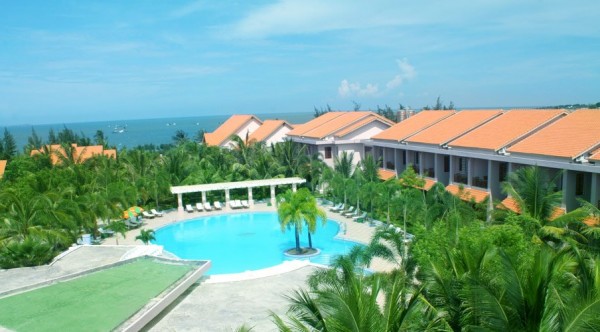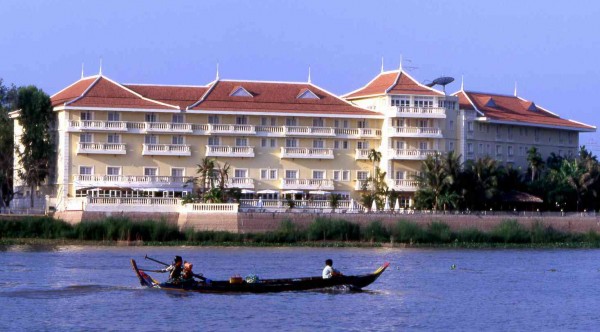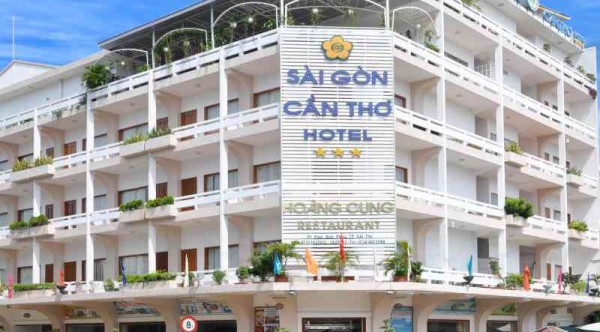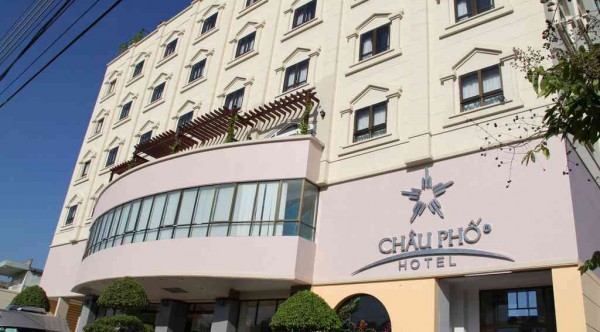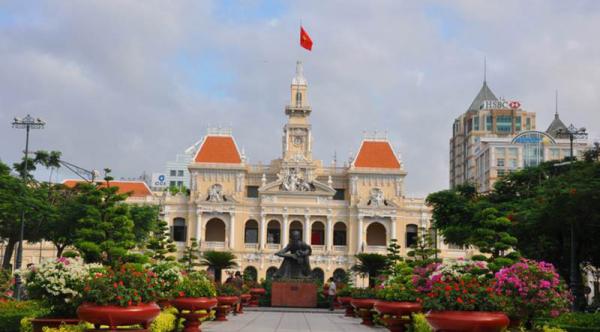
Mekong Delta – Land Of Rivers and Floating Markets

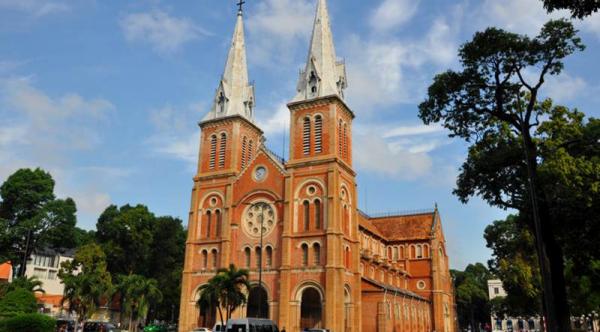
Ho Chi Minh City Tour – Day Trip
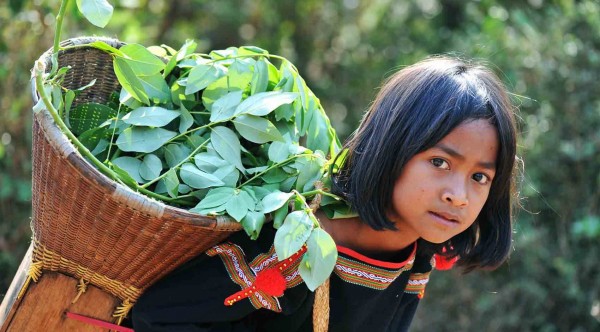
Central Highland Vietnam Photography Tour – 8 Days/7 Nights

Southern Vietnam Tour – 3 Days/ 2 Nights
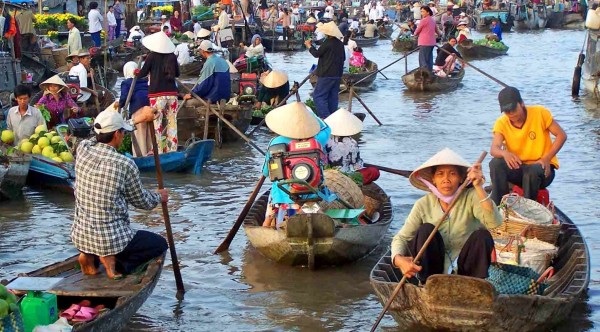
Southern Vietnam Tour – 4 Days/ 3 Nights

Long Tan – Nui Dat & Vung Tau – 2 Days
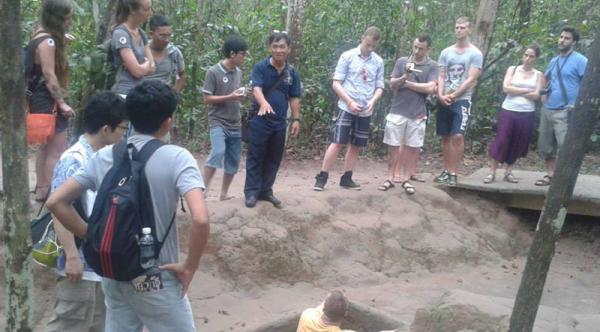
Tour to Cu Chi Tunnel & Cao Dai temple – Day Trip
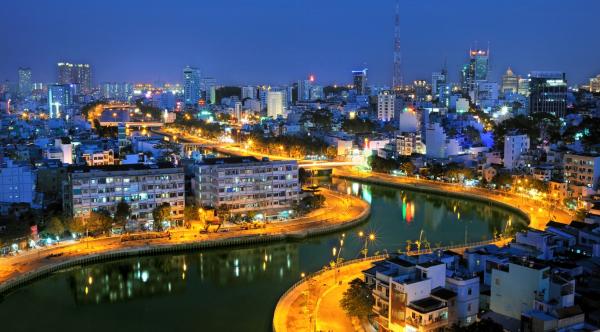
Cu Chi Tunnel Half Day Tour
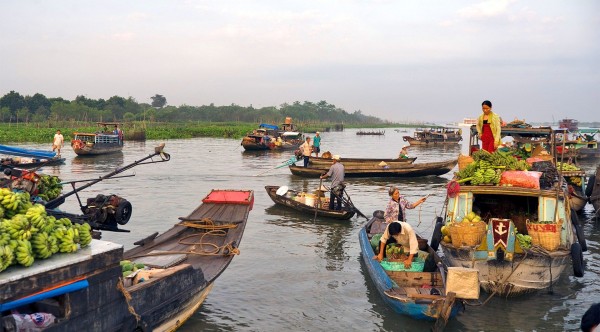
Mekong Delta – Cai Be Floating Market – Day Trip
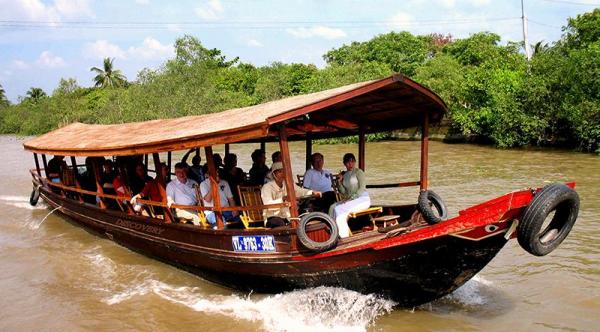
Mekong Delta – My Tho Tour – Day Trip

Saigon – Mekong Delta – Phu Quoc Island Tour – 7 Days/ 6...
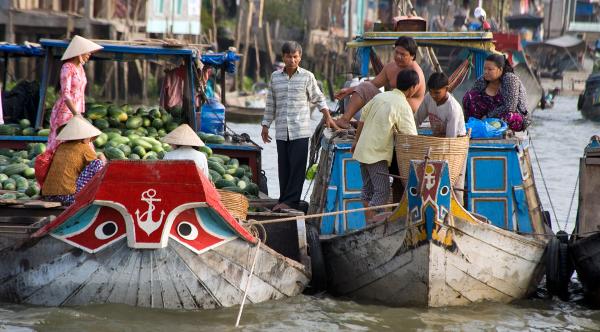
Cai Be Floating Market and Can Tho Tour – 2 Days/ 1 Night
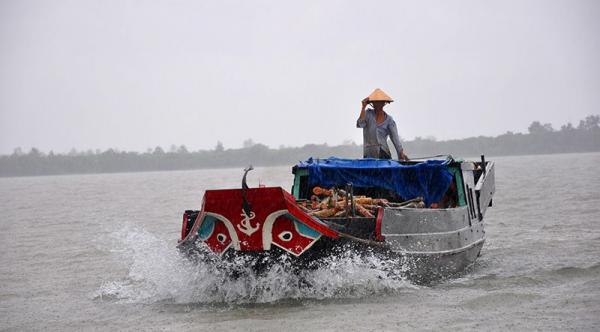
Discovery Mekong Delta River – 2 Days/ 1 Night

A Glimpse Of Mekong Delta – Escape To Phu Quoc Beach – 3 Days/ 2 Nights
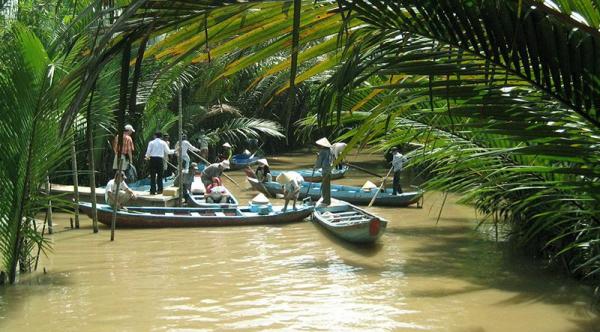
DAILY TRIP MEKONG DELTA ON MEKONG BOAT
Mekong Delta – Land Of Rivers and Floating Markets

The ‘rice bowl’ of Vietnam, the Mekong Delta is a landscape carpeted in a dizzying variety of greens and slashed with mighty waterways. It’s a water world where boats, houses, restaurants and even markets float upon the innumerable rivers, canals and streams that flow through the region like arteries. At times you can quite simply lose sight of land.
The area is both riparian and deeply rural, but it’s also one of Vietnam’s most densely populated regions, with nearly every hectare intensively farmed. Visitors can dwell on southern charm in little-visited riverside cities, sample fruits traded in the colourful floating markets, or feast on home-cooked delicacies before overnighting as a homestay guest. Mangrove forests, sacred Khmer pagodas and off-the-beaten-track attractions round out the picture.
Those seeking tropical hideaways can come ashore on Phu Quoc, a divine forested island fringed with white-sand beaches and crisscrossed with empty dirt roads that simply beg for motorbike exploration.
When the best time to visit Mekong Delta
The Mekong Delta reveals its best during dry months from December to May when the sky is crystal clear, the land is lush and the water is calm. From June to September, it may be hot and humid but the greatest variety of tropical fruit is available only in these months. During October and November, occasional flooding is expected, especially in remote areas around Dong Thap and Tra Vinh, so stay informed of regional weather forecast ahead of your trip if you are travelling in these months.
Life in Mekong Delta is woven by water and season. It is most vibrant in spring (flower season: late January – March) and early summer (fruit season: April – May), the best time to visit Mekong Delta, also the best time to visit Ho Chi Minh city and Vietnam in general. The flood season (September – November), however, sweeps everything away and brings a new face to the delta with its rich brown alluvial water. This is also the income season for local people with abundant fish and water vegetables. The waterfront life is most fascinating in this season.
Getting There & Away
Air
Flights head from Hanoi to Can Tho and from Ho Chi Minh City to Rach Gia and Ca Mau. Phu Quoc Island’s new international airport welcomes flights from Hanoi, Ho Chi Minh City, Can Tho and Rach Gia.
Bus
It’s surprisingly easy to travel the delta using public transport, and bus connections are excellent. Each urban Centre has a bus station for both buses and minibuses – although it’s usually located on the edge of town, requiring a short xe om (motorbike taxi) or taxi ride to your hotel. Minibuses tend to be faster, moderately more comfortable and not much more expensive.
Coming from Ho Chi Minh City, delta buses leave from Mien Tay bus station, 10km west of the Centre. To avoid the slight inconvenience of reaching Mien Tay, consider booking one of the cheap day tours to My Tho departing from Ð Pham Ngu Lao and abandoning the tour after the boat trip.
Boat
Some delta towns have ferry connections between them – a fascinating way to travel. The journey between Ca Mau and Rach Gia is particularly scenic. Boats to Phu Quoc Island leave from Rach Gia and Ha Tien.
Sights & Activities
Tram Chim National Park
Tram Chim National Park is due north of Cao Lanh in Tam Nong district and notable for its eastern sarus cranes (Grus antigone sharpii) . More than 220 species of bird have been identified within the reserve, but ornithologists will be most interested in these rare red-headed cranes, which grow to an impressive 1.8m high.
Seeing these birds, however, requires a considerable commitment (time, effort and money), so it’s strictly for enthusiasts.
Birds nest here from about December to May; from June to November they migrate to northwest Cambodia, so schedule your visit to coordinate with the birds’ travel itinerary if you want to see them. The birds are early risers, so morning visits are advised. During the day, they’re engaged in the important business of eating.
Mac Cuu Family Tombs
Not far from town are the Mac Cuu Family Tombs, known locally as Nui Lang, the Hill of the Tombs. Several dozen relatives of Mac Cuu are buried here in traditional Chinese tombs decorated with figures of dragons, phoenixes, lions and guardians. At the bottom of the complex is an ornate shrine dedicated to the Mac family.
Heading up the hill, the largest tomb is that of Mac Cuu himself, constructed in 1809 on the orders of Emperor Gia Long and decorated with carved figures of Thanh Long (Green Dragon) and Bach Ho (White Tiger), protectors of Taoist temples. The tomb of Mac Cuu’s first wife is flanked by the imperial symbols of dragons and phoenixes.
Temple of Lady Xu
Founded in the 1820s to house a statue that’s become the subject of a popular cult, this large temple faces Sam Mountain, on the same road as Tay An Pagoda. Originally a simple affair of bamboo and leaves, the temple has been rebuilt many times, most recently between 1972 and 1976, blending mid-20th-century design with Vietnamese Buddhist decorative motifs.
Xeo Quyt Forest
Southeast of Cao Lanh and accessible by boat tour is the magnificent 52-hectare Xeo Quyt Forest (also called Rung Tram) near My Hiep village. One vast swamp beneath a beautiful thick canopy of tall trees and vines, it’s one of the last natural forests left in the Mekong Delta.
During the rainy season a marvellous 20-minute canoe tour takes you past old bunkers and former mine fields along narrow canals filled with ever-present dragonflies and choked with water hyacinths (luc binh) . It’s an exquisite experience but splash on the repellent and try to get out by 4.30pm when the mozzies begin swarming. During the dry season you can explore this area on foot.
Cai Rang Floating Market
Just 6km from Can Tho in the direction of Soc Trang is Cai Rang, the biggest floating market in the Mekong Delta. There is a bridge here that serves as a great vantage point for photography. The market is best before 9am, although some vendors hang out until noon.
Cai Rang can be seen from the road, but getting here is far more interesting by boat. From the market area in Can Tho it takes about an hour by river, or you can drive to the Cau Dau Sau boat landing (by the Dau Sau Bridge), from where it takes only about 10 minutes to reach the market.
Cai Be Floating Market
This bustling river market is worth including on a boat tour from Vinh Long, but aim for an early morning visit. Wholesalers on big boats moor here, each specialising in just a few types of fruit or vegetable, hanging samples of their goods from tall wooden poles. A notable sight is the huge and photogenic Catholic cathedral on the riverside.
It takes about an hour to reach the market from Vinh Long, but most people make detours on the way there or back to see the canals or visit orchards. For those travelling on an organised tour of the delta, it is customary to board a boat here, explore the islands and moor in Vinh Long before continuing to Can Tho.
Phong Dien Floating Market
Perhaps the Mekong Delta’s best floating market, Phong Dien has fewer motorised craft and more stand-up rowing boats. Less crowded than Cai Rang, there are also far fewer tourists. It’s at its bustling best between 6am and 8am. The market is 20km southwest of Can Tho; most get here by road.
A boat trip here will require a 3.30am start, but you need to arrange it the day before. It is theoretically possible to do a whirlwind boat trip, visiting the small canals on the way and finishing back at the Cai Rang Floating Market. This journey should take approximately five hours return from Can Tho.
Floating Houses
These houses, whose floats consist of empty metal drums, are both a place to live and a livelihood for their residents. Under each house, fish are raised in suspended metal nets. The fish flourish in their natural river habitat, the family can feed them whatever scraps are handy and catching the fish requires less exertion than fishing.
You can find these houses floating around Chau Doc and get a close-up look by hiring a boat (but please be respectful of their occupants’ privacy).
Tomb of Thoai Ngoc Hau
A high-ranking official, Thoai Ngoc Hau (1761–1829) served the Nguyen Lords and, later, the Nguyen dynasty. In early 1829, Thoai Ngoc Hau ordered that a tomb be constructed for himself at the foot of Sam Mountain. The site he chose is nearly opposite the Temple of Lady Xu.
The steps are made of red ‘beehive’ stone (da ong) brought from the southeastern part of Vietnam. In the middle of the platform is the tomb of Thoai Ngoc Hau and those of his wives, Chau Thi Te and Truong Thi Miet. There’s a shrine at the rear and several dozen other tombs in the vicinity where his officials are buried.
Clay Pagoda
Buu Son Tu (Precious Mountain Temple) was founded over 200 years ago by a Chinese family named Ngo. Unassuming from the outside, this temple is highly unusual in that nearly every object inside is made entirely of clay. Consequently, it is better known as Chua Dat Set, or Clay Pagoda.
The hundreds of statues and sculptures that adorn the interior were hand-sculpted by the monk Ngo Kim Tong. From the age of 20 until his death at 62, this ingenious artisan dedicated his life to decorating the pagoda. Though the decor borders on kitsch, the pagoda is an active place of worship, and totally different from the Khmer and Vietnamese pagodas elsewhere in Soc Trang.
Fish Sauce Factory
The distillery of Nuoc Mam Hung Thanh is the largest of Phu Quoc’s fish-sauce makers, a short walk from the market in Duong Dong. At first glance, the giant wooden vats may make you think you’ve arrived for a wine tasting, but one sniff of the festering nuoc mam essence jolts you back to reality.
Most of the sauce produced is exported to the mainland for domestic consumption, though an impressive amount finds its way abroad to kitchens in Japan, North America and Europe. There’s no admission charge to visit, although you’d be best off taking a guide along unless you speak Vietnamese. Keep in mind that although nuoc mam makes a wonderful gift for your distant relatives, you may not be able to take it out of the country. Vietnam Airlines, among other carriers, has banned it from its planes.
Eating
– Mekong Rest Stop: Highway 60, My Tho; About 8km west of town, this complex includes a thatched-roof restaurant and some of the best bathrooms this side of Ho Chi Minh City. While it serves a good assortment of fresh seafood and traditional dishes amid the lush gardens, it does get overrun with tour groups passing through the delta.
– La Ca: 118/15A Ð Tran Van Kheo, Can Tho; This stylish barbecue restaurant is fun, unless you happen to be a suckling pig, the house specialty (you can order a whole one for 360,000d). The menu is typically huge, with a few Western and Korean dishes to even it out. Staffs are on roller-skates to speed up the service. It’s east of the central market, on the same main street.
– Restaurant Alley: If you fancy skipping the main tourist scene on the riverfront, then try this small alley between Ð Dien Bien Phu and Ð Phan Dinh Phung, Can Tho where there are about a dozen local restaurants scattered on both sides of the street. Barbecued meats, seafood hotpots and simple vegetables, it’s all here.
| Country | vietnam |
|---|

